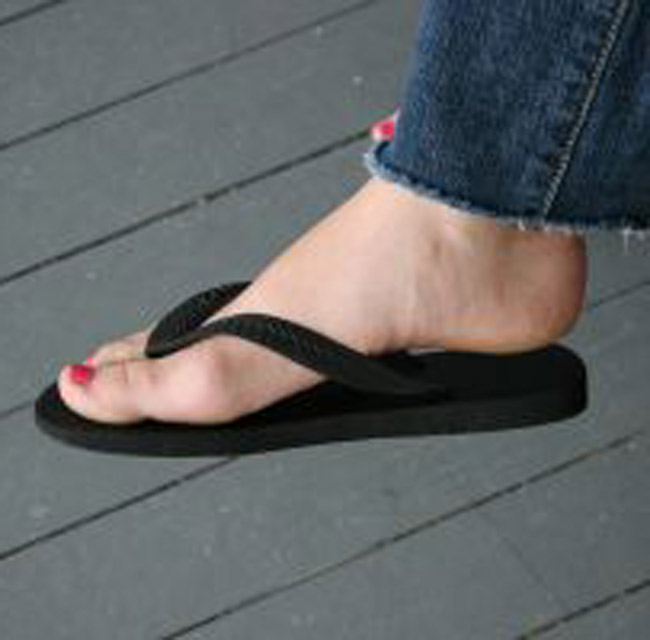Flip-Flops Bad For Feet

Flip-flops are named for the sound they make when you walk — flip, flop, flip, flop — but they could have been called ouch-umphs, the sound you'll make after wearing them all the time.
Researchers at Auburn University have found that wearing flip-flops alters the way one walks, changing the gait in subtle ways that can lead to serious sole, heel and ankle problems. They presented these findings earlier this month at the annual meeting of the American College of Sports Medicine in Indianapolis.
Casual flip-flop use is fine, they said. But driven by a trend that less is better when it comes to healthy footwear, flip-flops have moved beyond the domain of beach bums to take their place among sturdier sandals as proper summer fashion day and night.
Flip-flops might feel good because they keep your feet cool. At issue, though, is their utter lack of foot support.
Walk this way
The Auburn team videotaped 39 flip-flop-wearing volunteers and noticed how they scrunched their toes to keep the flip-flip on the foot while the heel lifted in the air. This motion stretches the plantar fascia, the connective tissue that runs from heel to toe, causing inflammation, pain along the sole, heel spurs and tired feet in general.
These symptoms were actually what flip-flop wearers at Auburn University had reported upon returning to classes in the fall. An entire summer of flip-flop wearing had taken its toll.
Sign up for the Live Science daily newsletter now
Get the world’s most fascinating discoveries delivered straight to your inbox.
The researchers also found that the volunteers altered their gait , taking shorter strides and turning their ankles inward, likely to keep the flip-flop from falling off. This, the researchers worry, can cause long-term ankle and hip problems.
Sandals with heel straps are the healthier choice because your foot doesn't need to clench to keep the footwear secure. These kinds of shoes offer better arch and heel support, too.
Better barefoot?
Barefooters, or those who shall remain shoeless, believe that walking barefoot is healthier than walking in any kind of shoe. They use the "natural" argument to explain how humans were never meant to wear shoes and that they take joy in what they call walking as nature intended.
No one can deny that joy, aside from podiatrists making a fist-load of money on their bruised feet. But as stated before in this column, nature has no intent. Nature is merely a framework in which humans evolved to live about 20 years, mate and die.
There's a reason why humans created shoes tens of thousands of years ago. Nature sucks. Aside from cold snow, blistering hot sand or jagged rocks, there was disease-ridden muck to negotiate. Not wearing clothes is natural, but clothes become a necessity in the 90 percent of the world that gets too cold to stay naked.
Groups such as the Society for Barefoot Living have captivating reasons for going barefoot most of the time, even for tromps through the city. Walking barefoot on clean pavement doesn't seem to hurt your feet, ankles or knees if you ease yourself into this routine. In this respect, walking barefoot is healthier than walking in ill-fitting or flimsy shoes, such as flip-flops or high-heals.
This works, however, only because we live in an industrialized country that has created numerous unnatural things, such as sewage systems and smoothly paved public areas.
A stroll through the doo
Reality is better relayed by groups such as Shoes for Humanity, cognizant of the fact that worms and myriad other parasites can gain access into the body through the foot. In most parts of the world, going barefoot is stubborn sign of impoverishment, not a natural, healthy alternative to footwear.
The risk of contracting hookworm is low for American barefooters because the chance of stepping in human feces containing the hookworm larvae is low. Not so for the estimated one billion humans worldwide infected with hookworm.
Not so for dogs, either, who for the most part don't wear shoes, aside from atrocities committed backstage at the Westminster Kennel Club dog show. Dogs get canine hookworm from walking in doggie doo. All land animals are susceptible to infections through their feet.
America barefooters still face real risks, such as glass and other sharp objects that can carry the tetanus neurotoxin. Barefooters also run the risk of never being invited to an Asian home, because they can't take off their feet.
Christopher Wanjek is the author of the books "Bad Medicine" and "Food At Work." Got a question about Bad Medicine? Email Wanjek. If it’s really bad, he just might answer it in a future column. Bad Medicine appears each Tuesday on LiveScience.

Christopher Wanjek is a Live Science contributor and a health and science writer. He is the author of three science books: Spacefarers (2020), Food at Work (2005) and Bad Medicine (2003). His "Food at Work" book and project, concerning workers' health, safety and productivity, was commissioned by the U.N.'s International Labor Organization. For Live Science, Christopher covers public health, nutrition and biology, and he has written extensively for The Washington Post and Sky & Telescope among others, as well as for the NASA Goddard Space Flight Center, where he was a senior writer. Christopher holds a Master of Health degree from Harvard School of Public Health and a degree in journalism from Temple University.









